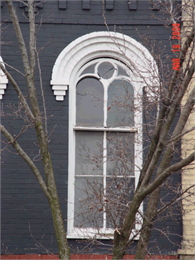Rehabilitating Painted Surfaces in Your Historic Building

One common way to paint your historic house is to select a field color, such as grey, and then a contrasting color for the trim, such as white. A third color can be used to paint the windows if desired. Source: Phil Thomason.
Your historic house or commercial building has painted finishes everywhere: wood siding, exterior wood trim, porch millwork and floors, eaves and brackets, interior woodwork, faux wood grained interior woodwork, plaster walls and ceilings, cabinets, sometimes masonry and even early interior floors. The age, style and level of detail of your house or building determine the types and varieties of painted surfaces, both inside and outside.
Paint is one of the most important historic materials used to protect, beautify and maintain your historic house or commercial building. Paint helps to protect the wood siding of a building and adds color and variety to your building’s streetscape. You should preserve your old painted surfaces whenever possible. Often this is not practical because paint so readily peels, wears off and fails in other ways. In fact, if your historic house or commercial building is made of wood construction, it has likely been painted many times during its history.
Follow Best Practices

Various paint colors can be used to highlight architectural details. See the house in the image above for a good example. When more than three colors are used in a paint scheme, the end result may be confusing. Source: Phil Thomason.
When you are making decisions about the painted surfaces on the exterior or interior of your historic house or commercial building, follow these best practices:
- Maintain the original painted (or unpainted) appearance of your historic house or building. It is particularly important to retain the original finishes in your historic structure if your property is a house museum, individually listed on the National Register of Historic Places, or designated as a National Historic Landmark. Follow the guidance of the Secretary of the Interior’s Standards for Rehabilitation or the equivalent standards for restoration to maintain your building’s painted surfaces. Although your local preservation ordinance might require design approval for your chosen paint colors, most communities do not regulate paint color choices for historic houses and buildings.
- EnlargeDo not paint your masonry house or building if it has never been painted before. Most masonry and concrete buildings were never meant to be painted. If you paint your previously unpainted masonry, you will compromise the original design of your house or building and add the unnecessary expense of regular paint maintenance and periodic repainting. In addition, the use of paint as a sealer prevents water vapor from escaping, which can be destructive to masonry. If paint was added to your masonry structure at some point, consider removing the paint.

Jones Block, 1868
Burlington, Wisconsin. Very few brick buildings were originally painted. Unless your building was one of the few, exterior brick should not be painted. Source: Stelling & Associates Architects, Ltd.
- Use nonabrasive methods to remove paint. When you need to remove paint, use non-abrasive methods such as chemical cleaning, hand-scraping or hand-sanding. Remove damaged or deteriorated paint down to the next sound layer. Protect your historic materials while you are removing paint.
- Maintain or re-establish your historic color scheme. When you are preparing to repaint your historic house or building, try to determine the original paint scheme. If you cannot determine the original color scheme, use historic paint schemes to guide your decision on a new color scheme. Use a comprehensive color scheme for your building’s entire exterior, so your upper and lower floors and subordinate trimwork appear as components of a single building.
- Document your historic paint colors. If you cannot save any original paint on your historic house or building, document the original colors with paint samples or photographs. Future owners of your structure might be interested in the original or replacement paint colors so they can return the structure to its original or earlier appearance.


